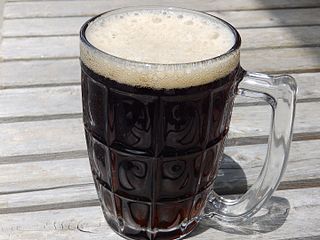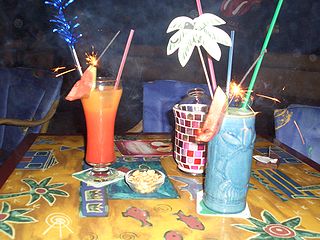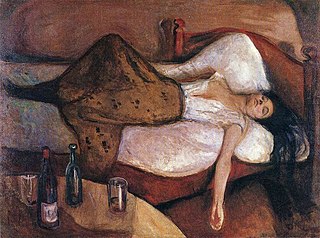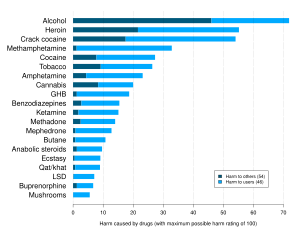Related Research Articles

An alcopop is any of certain flavored alcoholic beverages with relatively low alcohol content, including:
- Malt beverages to which various fruit juices or other flavorings have been added
- Beverages containing wine to which ingredients such as fruit juice or other flavorings have been added
- Beverages containing distilled alcohol and sweet liquids such as fruit juices or other flavourings

Beer is one of the oldest and most widely consumed alcoholic drinks in the world. It is also the third most popular drink overall after water and tea. Beer is brewed from cereal grains—most commonly from malted barley, though wheat, maize (corn), and rice are also used. During the brewing process, fermentation of the starch sugars in the wort produces ethanol and carbonation in the resulting beer. Most modern beer is brewed with hops, which add bitterness and other flavours and act as a natural preservative and stabilizing agent. Other flavouring agents such as gruit, herbs, or fruits may be included or used instead of hops. In commercial brewing, the natural carbonation effect is often removed during processing and replaced with forced carbonation.

A drink is a liquid intended for human consumption. In addition to their basic function of satisfying thirst, drinks play important roles in human culture. Common types of drinks include plain drinking water, milk, coffee, tea, hot chocolate, juice and soft drinks. In addition, alcoholic drinks such as wine, beer, and liquor, which contain the drug ethanol, have been part of human culture for more than 8,000 years.

Root beer is a sweet North American beverage traditionally made using the root bark of the sassafras tree Sassafras albidum or the vine of Smilax ornata (sarsaparilla) as the primary flavor. Root beer is typically but not exclusively non-alcoholic, caffeine-free, and carbonated. It usually has a thick and foamy head when poured. Modern, commercially produced root beer is generally sweet, foamy, carbonated, non-alcoholic, and flavored using artificial sassafras flavoring. Sassafras root is still used to flavor traditional root beer, but since sassafras was banned by the U.S. Food and Drug Administration due to the carcinogenicity of its constituent safrole, most commercial recipes do not contain sassafras. Some commercial root beers do use a safrole-free sassafras extract. Major producers include A&W Root Beer, Barq's, Dad's Root Beer, Hires Root Beer, and Mug Root Beer.

A mixed drink is a beverage in which two or more ingredients are mixed. Some contain liquor, others are non-alcoholic. A "spirit and mixer" is any combination of one spirit with one non-alcoholic component, such as gin and tonic, whereas a "cocktail" generally comprises three or more ingredients.

Ginger ale is a carbonated soft drink flavoured with ginger. It is consumed on its own or used as a mixer, often with spirit-based drinks. There are two main types of ginger ale. The golden style is credited to the Irish doctor Thomas Joseph Cantrell. The dry style, a paler drink with a much milder ginger flavour, was created by Canadian John McLaughlin.

Ethyl carbamate (also called urethane) is an organic compound with the formula CH3CH2OC(O)NH2. It is an ester of carbamic acid. It is a white solid. Despite its name, it is not a component of polyurethanes. Because it is a carcinogen, it is little used, but it naturally forms in low quantities in many types of fermented foods and drinks.

Traditional ginger beer is a sweetened and carbonated, usually non-alcoholic beverage. It is produced by the natural fermentation of prepared ginger spice, yeast and sugar.

Purposeful production of alcoholic drinks is common and often reflects cultural and religious peculiarities as much as geographical and sociological conditions.

Alcohol is any organic compound in which a hydroxyl functional group (-OH) is bound to a carbon atom, usually connected to other carbon or hydrogen atoms. An important class are the simple acyclic alcohols, the general formula for which is CnH2n+1OH. Of those, ethanol (C2H5OH) is the type of alcohol found in alcoholic beverages, and in common speech the word alcohol refers specifically to ethanol. Articles related to alcohol include:

A hangover is the experience of various unpleasant physiological and psychological effects following the consumption of alcohol, such as wine, beer and distilled spirits. Hangovers can last for several hours or for more than 24 hours. Typical symptoms of a hangover may include headache, drowsiness, concentration problems, dry mouth, dizziness, fatigue, gastrointestinal distress, absence of hunger, light sensitivity, depression, sweating, nausea, hyper-excitability, irritability and anxiety.

An alcoholic drink is a drink that contains ethanol, a type of alcohol produced by fermentation of grains, fruits, or other sources of sugar. The consumption of alcohol plays an important social role in many cultures. Most countries have laws regulating the production, sale, and consumption of alcoholic beverages. Some countries ban such activities entirely, but alcoholic drinks are legal in most parts of the world. The global alcoholic drink industry exceeded $1 trillion in 2018.

The short-term effects of alcohol consumption – due to drinking beer, wine, distilled spirits or other alcoholic beverages – range from a decrease in anxiety and motor skills and euphoria at lower doses to intoxication (drunkenness), stupor, unconsciousness, anterograde amnesia, and central nervous system depression at higher doses. Cell membranes are highly permeable to alcohol, so once alcohol is in the bloodstream, it can diffuse into nearly every cell in the body.
When drinking beer, there are many factors to be considered. Principal among them are bitterness, the variety of flavours present in the beverage and their intensity, alcohol content, and colour. Standards for those characteristics allow a more objective and uniform determination to be made on the overall qualities of any beer.
In the alcoholic beverages industry, congeners are substances, other than the desired type of alcohol, ethanol, produced during fermentation. These substances include small amounts of chemicals such as methanol and other alcohols, acetone, acetaldehyde, esters, tannins, and aldehydes. Congeners are responsible for most of the taste and aroma of distilled alcoholic beverages, and contribute to the taste of non-distilled drinks. It has been suggested that these substances contribute to the symptoms of a hangover.

Methanol toxicity is poisoning from methanol. Symptoms may include a decreased level of consciousness, poor coordination, vomiting, abdominal pain, and a specific smell on the breath. Decreased vision may start as early as twelve hours after exposure. Long-term outcomes may include blindness and kidney failure. Toxicity and death may occur even after drinking a small amount.

Alcohol, sometimes referred to by the chemical name ethanol, is a psychoactive drug that is the active ingredient in drinks such as beer, wine, and distilled spirits. It is one of the oldest and most common recreational substances, causing the characteristic effects of alcohol intoxication ("drunkenness"). Among other effects, alcohol produces a mood lift and euphoria, decreased anxiety, increased sociability, sedation, impairment of cognitive, memory, motor, and sensory function, and generalized depression of central nervous system function. Ethanol is only one of several types of alcohol, but it is the only type of alcohol that is found in alcoholic beverages or commonly used for recreational purposes; other alcohols such as methanol and isopropyl alcohol are toxic.
Alcohol-induced respiratory reactions, also termed alcohol-induced asthma and alcohol-induced respiratory symptoms, are increasingly recognized as a pathological bronchoconstriction response to the consumption of alcohol that afflicts many people with a "classical" form of asthma, the airway constriction disease evoked by the inhalation of allergens. Alcohol-induced respiratory reactions reflect the operation of different and often racially related mechanisms that differ from those of classical, allergen-induced asthma.
References
- ↑ Bonte, W., Congener Analysis, in Encyclopedia of Forensic Sciences. 2000, Academic Press: Duesseldorf, Germany. p. 93-102.
- ↑ Iffland, R. and A.W. Jones, Evaluating alleged drinking after driving - the hip-flask defence. Part Congener analysis. Med Sci Law, 2003. 43(1): p. 39-68.
- ↑ González-Arjona, D., et al., Authentication and differentiation of Irish whiskeys by higher-alcohol congener analysis. Analytica Chimica Acta, 1999. 381(2-3): p. 257-264.
- ↑ Rodda, L. N., J. Beyer, D. Gerostamoulos and O. H. Drummer (2013). "Alcohol congener analysis and the source of alcohol: a review." Forensic Sci Med Pathol 9(2): 194-207.
- ↑ Rodda, L. N., D. Gerostamoulos and O. H. Drummer (2013). "The rapid identification and quantification of iso-alpha-acids and reduced iso-alpha-acids in blood using UHPLC-MS/MS: validation of a novel marker for beer consumption." Anal Bioanal Chem 405(30): 9755-9767.
